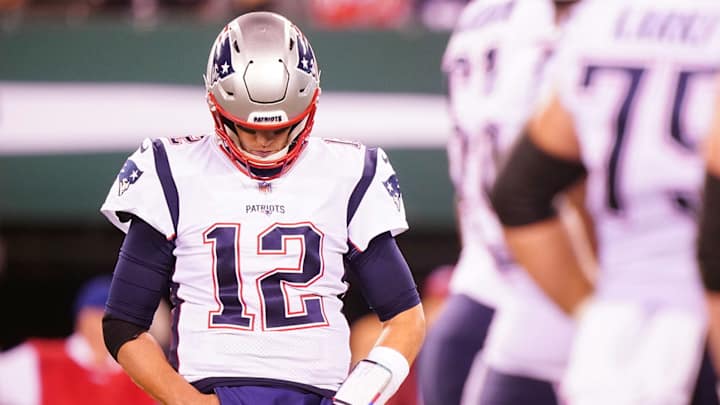Where Do Old QBs Fit in the New NFL?

Tom Brady was spry, moving nimbly in the pocket and firing passes over and around hapless defenders and into the clutches of his intended targets. The Patriots were unstoppable, and it seemed Brady was embarking on a reign of dominance that would last years, perhaps decades. But that was 2018. A lot has changed since then.
A new wave of quarterbacks, led by reigning Super Bowl MVP Patrick Mahomes and unanimous regular-season MVP Lamar Jackson, has captured the collective imagination of the football world, just as aging passers like Brady (age 42), Drew Brees (41) and Philip Rivers (38) have begun to struggle. Now, those three future Hall of Famers are set to hit unrestricted free agency, with the Chargers moving on from Rivers and a real possibility that Brady could also change teams for the first time in his career. That raises a question: Just one year after it looked as if all three could play forever, is there still a place in the NFL for an aging pocket QB?
* * *

To understand the sustained excellence of Brady, Rivers and Brees, you must first understand what lies at the heart of their success. It’s the same thing that’s at the root of all the most exciting things life has to offer: geometry.
Space is limited on an NFL field—far more than at the college level, where wider hashmarks create huge swaths of open field in which solitary defenders can be exploited. The tighter, centered hashmarks in the pros guarantee that every play starts near the middle, creating a claustrophobic feel that’s only enhanced by the 11 all-world athletes patrolling the other side of the line.
To win in the passing games, offenses try to dictate matchups that isolate the offensive player against an overmatched defensive player. Or they draw up designs that feature intertwined routes (Player A draws a defender away from the area that Player B will then fill) and spacing between receivers that maximizes the area each defender must cover. The point of origin for all those passing designs is the pocket; if the quarterback drifts too far back, or too far to either side, he compromises the angles of his throwing windows and disrupts the intricate timing of the play.
Often, the QBs who execute best are those who can decipher a defense before the snap, then hang in the pocket and anticipate how opposing defenders are going to move as the play unfolds. While we attribute intelligence to that—“reading” a defense sounds like real nerd stuff—it is more a product of seeing the plays unfold in real time over and over and over. There are young quarterbacks fully capable of doing this, but a veteran’s mental rolodex is a major strength. Throw in a decade of rule changes that limit the punishment a quarterback takes in the pocket—contact may only be initiated within a strike zone the area of a QB’s belt buckle, and to complete a sack the defender must lay the passer to the turf like a mother placing her newborn into a bassinet—and you have a league built for the aging quarterback.
To be clear: The NFL isn’t built only for the aging quarterback. The out-of-structure magic of Mahomes (also a truly elite quarterback in-structure) and Deshaun Watson—not to mention veterans Aaron Rodgers and Russell Wilson—can generate plenty of offense. The ability of Lamar Jackson to beat defenses as a designed passer, designed runner or second-reaction threat could make him unstoppable over the next decade. And some basic game theory—defenses invested in lighter, faster players to counter those pass-happy offenses, so the Titans countered with an offense built around a 250-pound running back—have led to a renaissance of the running game.
But the point is, those old pocket passers get the job done.
* * *

So how did it go so wrong for Brady and Rivers last year? Pass protection has been an issue for the Chargers the past couple of years, and Rivers has struggled to find time within the pocket. Fading arm strength has made downfield passing a challenge, and forced throws—some necessarily desperate, others the result of being frazzled—led to a 20-interception 2019 season. L.A. finished 5–11 in 2019 thanks largely to their record in games decided by one possession: 2–9. They were 6–1 in similar games the year before, when they went 12–4.
As for Brady, the Patriots lost a lot of talent in the passing game and failed in trying to replace it. Regardless of a running style that could only be described as “centaur with two sprained ankles” during the 2018 season, tight end Rob Gronkowski remained a force that required double-coverage. His ability to line up at different spots in the formation often tipped an opposing defense’s plan and his run-blocking ability (along with fullback James Develin, who missed most of 2019 with a neck injury) allowed the Pats to ramp up their run game in the second half of ’18. Last year, with Gronk retired, talented-but-troubled receiver Josh Gordon lasted only until Halloween before getting cut, and Antonio Brown made it through 13 days and 24 snaps before his abhorrent off-field behavior became too much to tolerate. First-round pick N’Keal Harry missed the first half with an ankle injury and never became a factor. Behind stalwarts Julian Edelman and James White, Brady’s most-targeted receivers were trade acquisition Mohamed Sanu, who was unable to separate in coverage and often struggled to simply catch the ball, and undersized speedster Phillip Dorsett, who developed an uncanny knack for being anywhere but the spot where Brady thought he was going to be. With the offensive line downgraded after the loss of center David Andrews, and the ground game bringing little on the week-to-week basis, Brady had arguably the worst season of his NFL career.
Brees, for his part, will almost surely return to New Orleans. Still, his diminishing arm strength has limited the Saints’ downfield passing game the past two postseasons: In the overtime loss to the Vikings this January, it was gadget weapon Taysom Hill attempting (and completing) the Saints’ lone deep shot.
But how many teams have proper talent and an opening at quarterback? April’s draft could yield as many as six first-round QBs. There’s also a relative flooding of the free-agent market, and Andy Dalton, Derek Carr and Cam Newton might also become available.
Rivers has been linked to Tampa Bay, where he’d play in a Bruce Arians offense that generated a late-career renaissance for Carson Palmer with the Cardinals. It also might make sense to reunite with Colts coach Frank Reich, Rivers’s position coach and offensive coordinator from 2013 to ’15.
Would Brady reunite with an ex-teammate, Titans head coach Mike Vrabel, in Nashville? Tennessee’s dominating run game might remind Brady of the offense New England used in the second half of 2018. Would he be interested in cutting the ribbon on the NFL’s newest home, Las Vegas? The Raiders are solid on the offensive line but, pending offseason improvements, have a shortage of weapons. Plus, the Patriots’ defense was capable of carrying the team last year; the Raiders’ is not. Could he be the one who replaces Rivers as the Chargers open a new stadium? The Chargers’ problem is inverse of the Raiders’: plenty of weapons, but an atrocious O-line.
Of course, Brady could choose to return to Foxboro, team up once again with the greatest coach of all time and ride an elite defense to his seventh ring. A high pick from a receiver-rich draft class, or acquiring a true No. 1 receiver in free agency, could perhaps seal the deal. Maybe the best tack is to try to recapture the magic from the days when his arm was young, the wins rolled in and the future was never brighter than in 2018.
A version of this story appears in the March 2020 issue of Sports Illustrated. To subscribe, click here.
